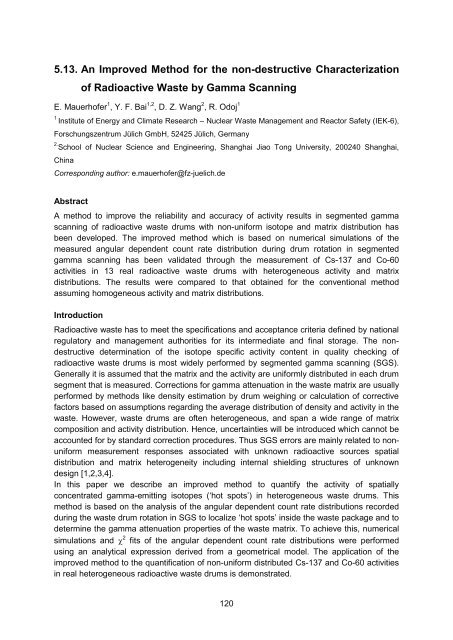Annual Report 2009/2010 - JUWEL - Forschungszentrum Jülich
Annual Report 2009/2010 - JUWEL - Forschungszentrum Jülich
Annual Report 2009/2010 - JUWEL - Forschungszentrum Jülich
Create successful ePaper yourself
Turn your PDF publications into a flip-book with our unique Google optimized e-Paper software.
5.13. An Improved Method for the non-destructive Characterization<br />
of Radioactive Waste by Gamma Scanning<br />
E. Mauerhofer 1 , Y. F. Bai 1,2 , D. Z. Wang 2 , R. Odoj 1<br />
1<br />
Institute of Energy and Climate Research – Nuclear Waste Management and Reactor Safety (IEK-6),<br />
<strong>Forschungszentrum</strong> <strong>Jülich</strong> GmbH, 52425 <strong>Jülich</strong>, Germany<br />
2. School of Nuclear Science and Engineering, Shanghai Jiao Tong University, 200240 Shanghai,<br />
China<br />
Corresponding author: e.mauerhofer@fz-juelich.de<br />
Abstract<br />
A method to improve the reliability and accuracy of activity results in segmented gamma<br />
scanning of radioactive waste drums with non-uniform isotope and matrix distribution has<br />
been developed. The improved method which is based on numerical simulations of the<br />
measured angular dependent count rate distribution during drum rotation in segmented<br />
gamma scanning has been validated through the measurement of Cs-137 and Co-60<br />
activities in 13 real radioactive waste drums with heterogeneous activity and matrix<br />
distributions. The results were compared to that obtained for the conventional method<br />
assuming homogeneous activity and matrix distributions.<br />
Introduction<br />
Radioactive waste has to meet the specifications and acceptance criteria defined by national<br />
regulatory and management authorities for its intermediate and final storage. The nondestructive<br />
determination of the isotope specific activity content in quality checking of<br />
radioactive waste drums is most widely performed by segmented gamma scanning (SGS).<br />
Generally it is assumed that the matrix and the activity are uniformly distributed in each drum<br />
segment that is measured. Corrections for gamma attenuation in the waste matrix are usually<br />
performed by methods like density estimation by drum weighing or calculation of corrective<br />
factors based on assumptions regarding the average distribution of density and activity in the<br />
waste. However, waste drums are often heterogeneous, and span a wide range of matrix<br />
composition and activity distribution. Hence, uncertainties will be introduced which cannot be<br />
accounted for by standard correction procedures. Thus SGS errors are mainly related to nonuniform<br />
measurement responses associated with unknown radioactive sources spatial<br />
distribution and matrix heterogeneity including internal shielding structures of unknown<br />
design [1,2,3,4].<br />
In this paper we describe an improved method to quantify the activity of spatially<br />
concentrated gamma-emitting isotopes (‘hot spots’) in heterogeneous waste drums. This<br />
method is based on the analysis of the angular dependent count rate distributions recorded<br />
during the waste drum rotation in SGS to localize ‘hot spots’ inside the waste package and to<br />
determine the gamma attenuation properties of the waste matrix. To achieve this, numerical<br />
simulations and 2 fits of the angular dependent count rate distributions were performed<br />
using an analytical expression derived from a geometrical model. The application of the<br />
improved method to the quantification of non-uniform distributed Cs-137 and Co-60 activities<br />
in real heterogeneous radioactive waste drums is demonstrated.<br />
120
















